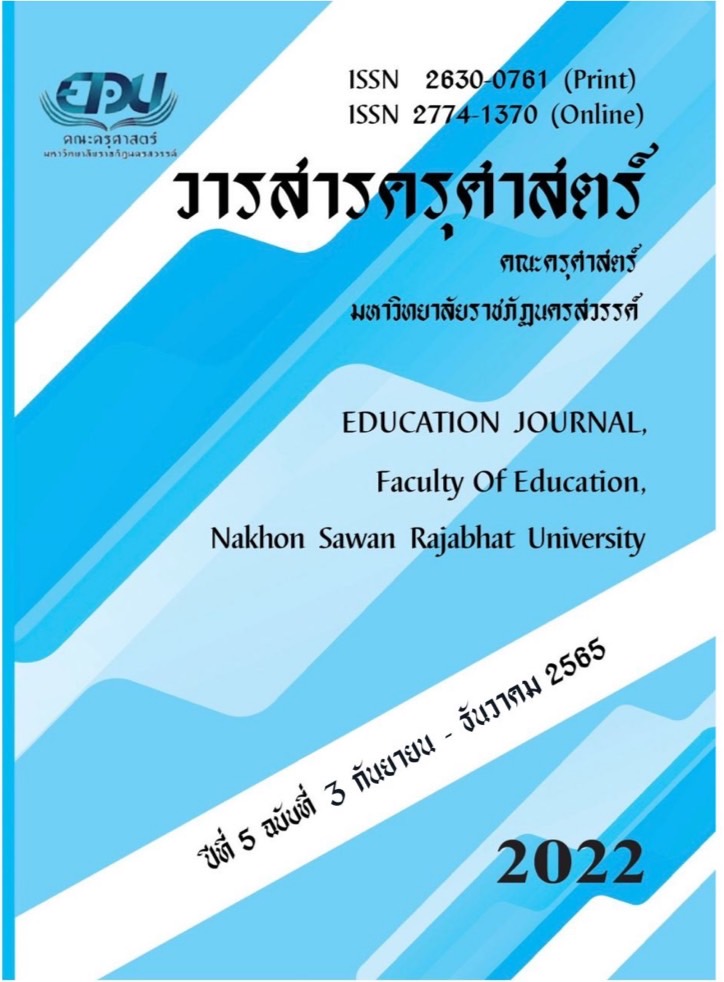แนวทางการจัดหลักสูตรเร่งรัดเพื่อพัฒนาทักษะการสื่อสารที่ส่งผลต่อคุณภาพชีวิต ของแรงงานต่างด้าวในประเทศไทย
Main Article Content
บทคัดย่อ
บทความนี้มีวัตถุประสงค์เพื่อวิเคราะห์แนวทางการจัดหลักสูตรเร่งรัดเพื่อพัฒนาทักษะการสื่อสารที่ส่งผลต่อคุณภาพชีวิตของแรงงานต่างด้าวในประเทศไทย ซึ่งเป็นกลุ่มแรงงานตามบันทึกความเข้าใจว่าด้วยความร่วมมือในการจ้างแรงงานระหว่างรัฐ MOU ซึ่งประกอบด้วย แรงงานสัญชาติเมียนมา ลาว กัมพูชา และเวียดนาม โดยแนวทางการจัดหลักสูตรประกอบด้วยแนวทางที่สำคัญ 4 แนวทาง คือ แนวทางการกำหนดวัตถุประสงค์ของหลักสูตรควรตอบสนองด้านการดำรงชีพได้ การทำงานได้ และการมีสุขได้, แนวทางการกำหนดเนื้อหาสาระควรบูรณาการทักษะการฟัง พูด อ่าน และเขียนในบริบท การสื่อสารเพื่อการดำรงชีพและการทำงานร่วมกับวัฒนธรรมของสังคมไทย, แนวทางการจัดประสบการณ์การเรียนรู้ ควรขับเคลื่อนด้วยแนวคิดการสอนภาษาแบบทางตรง และแนวทางการวัดประเมินผลควรเป็นลักษณะของการวัดผล เพื่อพัฒนาร่วมกับการวัดผลรวม พร้อมกับการออกแบบเกณฑ์ประเมินแบบยืดหยุ่นที่ช่วยสะท้อนทักษะการสื่อสารของผู้เรียนได้อย่างชัดเจนและนำสู่การพัฒนาได้อย่างมีประสิทธิภาพ ทั้งนี้การจัดหลักสูตรเร่งรัดตามแนวทางดังกล่าวจะเป็นเครื่องมือสำคัญในการพัฒนาทักษะการสื่อสารภาษาไทยให้กับแรงงานต่างสัญชาติในกระบวนการนำเข้าแรงงานต่างด้าวให้มีคุณภาพและประสิทธิภาพมากยิ่งขึ้น ซึ่งจะส่งผลต่อการเติบโตทางเศรษฐกิจของประเทศไทยให้เกิดประสิทธิผลได้ต่อไป
Downloads
Article Details

อนุญาตภายใต้เงื่อนไข Creative Commons Attribution-NonCommercial-NoDerivatives 4.0 International License.
เอกสารอ้างอิง
คมสันต์ นาควังไทร. (2560).คุณลักษณะของแรงงานชาวพม่าที่ตรงตามความต้องการของสถานประกอบการ. การประชุมวิชาการระดับชาติ ครั้งที่ 1 สถาบันวิจัยและพัฒนา มหาวิทยาลัยราชภัฏกำแพงเพชร, 21-28.
ชมนาถ นิตตะโย, โสภณ ธัญญาเวชกิจ, บวรวิทย์ จินดารักษ์ และนันทนิตย์ ทองศรี. (2563). เปิดข้อเท็จจริงแรงงานต่างด้านในไทย: ตอนที่ 1 แรงงานทักษะต่ำ. สืบค้นเมื่อ 5 มีนาคม 2565, จาก https://www.pier.or.th/abridged/2020/14/.
ติณณภพจ์ สินสมบูรณ์ทอง, วาทินีย์ วิชัยยา, และสรัญญา เตรัตน์. (2563). แนวปฏิบัติที่ดีในการพัฒนาทักษะแรงงานข้ามชาติ. รายงานการวิจัยโครงการส่งเสริมการย้ายถิ่นที่ปลอดภัย การพัฒนาทักษะฝีมือแรงงาน และการจ้างงานในประเทศกัมพูชา สาธารณรัฐประชาธิปไตยประชาชนลาว เมียนมา และไทย. สืบค้นเมื่อ 5 มีนาคม 2565, จาก https://mitrthai.com/employers/1.pdf.
ถิรภาพ ฟักทอง. (2559). แรงงานเมียนมากับเศรษฐกิจไทยในยุคปัจจุบัน. สืบค้นเมื่อ 5 มีนาคม 2565, จาก https://www.bangkokbiznews.com/blogs/columnist/112817.
ทรงชัย ทองปาน. (2563). สภาพปัญหาและข้อเสนอเชิงนโยบายที่เกี่ยวข้องกับแรงงานข้ามชาติในประเทศไทย: ผลจาก การสังเคราะห์งานวิจัยที่ได้รับการสนับสนุนจากสำนักงานคณะกรรมการวิจัยแห่งชาติ. วารสารสังคมวิจัยและพัฒนา, 2(4), 1 - 20.
นวลทิพย์ เพิ่มเกษร. (2552). การจัดหลักสูตรการสอนภาษาไทยในฐานะภาษาต่างประเทศ. วรรณวิทัศน์, 9(พฤศจิกายน), 107 - 120.
พนม เกตุมาน. (2561). จิตวิทยาเชิงบวกกับการเรียนรู้. สืบค้นเมื่อ 5 มีนาคม 2565, จาก https://drpanom.wordpress.com/2018/10/17/.
พัชรจิรา ตัณฑ์ประพันธ์. (2562). ความสามารถทางการสื่อสารของแรงงานต่างด้าวสัญชาติเมียนมาร์ในประเทศไทย. งานประชุมวิชาการระดับชาติ มหาวิทยาลัยรังสิต ประจำปี 2562, 1646 - 1655.
รุ่งทิวา จันทน์วัฒนวงษ์. (2557). การพัฒนาหลักสูตร. อุดรธานี: คณะครุศาสตร์ มหาวิทยาลัยราชภัฏอุดรธานี.
สรียา ทับทัน. (2549). แนวทางการสอนภาษาไทยให้แก่ชาวต่างชาติ. วารสารครุศาสตร์อุตสาหกรรม, 5(2), 87 - 93.
สำนักบริหารแรงงานต่างด้าว กรมการจัดหางาน. (2561). คู่มือสำหรับอบรมแรงงานต่างด้าวที่ได้รับอนุญาตทำงานในประเทศไทย. สืบค้นเมื่อ 2 เมษายน 2565, จาก https://www.doe.go.th/prd/assets/upload/files/ chiangrai_th/4b2fee86ec4282826f572e27d8e57d45.pdf
สุดารัตน์ พิมลรัตกานต์, และนรินทร์ สังข์รักษา. (2560). รูปแบบวิถีชีวิตของแรงงานต่างด้าวสัญชาติเมียนมาร์ในพื้นที่เขตคลองสามวา กรุงเทพมหานคร. วารสาร Veridian E-Journal, Silpakorn University ฉบับภาษาไทย สาขามนุษยศาสตร์ สังคมศาสตร์ และศิลปะ, 10(3), 2420 - 2439.
อริญพร โพธิใส. (2554). สิทธิในการทำงานของแรงงานต่างด้าวในประเทศไทย. จุลนิติ, 8(4), 175 - 184.
Black, P., & William, D. (2009). Developing the theory of formative assessment. Springer Science+Business Media, 5 - 31.
Hashem, D. (2017). 6 Reasons to try a single-point rubric. สืบค้นเมื่อ 2 เมษายน 2565, จาก
https://www.edutopia.org/article/6-reasons-try-single-point-rubric.
Li, S. (2019). The Comparison of the Role of Speaking Skills in the Direct Method, Audiolingual Method and Task-based Language Teaching. Advances in Social, Education and Humanities Research, 268(2), 271-281.
Nila Andriyani. (2015). Using the direct method in teaching to improve students’speaking skill at purikids language course. Thesis of Faculty of Languages and Arts Yogyakarta State University.
Scott, P. A. (2003). Attributes of High-Quality Intensive courses. New Directions for adult and continuing education, 29 - 38.
Someya K., & Saeed K. (2014). Classroom and Formative Assessment in Second/Foreign Language Teaching and Learning. Theory and Practice in Language Studies, 4(2), 435 - 440.


